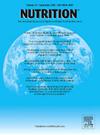Age-stratified validation and interrater reliability of the screening tool for nutritional risk for childhood cancer in hospitalized children
IF 3.2
3区 医学
Q2 NUTRITION & DIETETICS
引用次数: 0
Abstract
Objective
To evaluate the reliability, construct, and criterion validity of the screening tool for childhood cancer (SCAN), stratified by age in oncology patients admitted to a tertiary referral hospital.
Methods
Hospitalized children from birth to 18 years old, with an oncological diagnosis and expected length of stay (LOS) of >24 hours were included. Interrater and intrarrater agreements were used to evaluate the reliability of SCAN. Construct validity and criterion validity were explored in SCAN. Also, predictive validity was explored by comparing SCAN risk categories against LOS.
Results
Three hundred ninety-four children were included in the study. The scores obtained after dietitians and physicians used SCAN showed good agreement (ICC = 0.80, 95%CI 0.71–0.86, P < 0.001). The intrarrater agreement within the evaluation of the same dietitian to the same group of patients was also good (ICC = 0.83, 95%CI 0.75–0.88, P < 0.001). After applying SCAN, 66.2% of participants scored >3 points, classified as at risk of malnutrition. The agreement observed when comparing the risk classification given by the tool with the malnutrition assessment using anthropometry variables as the criterion reference was fair (κ = 0.22, 95%CI 0.15–0.29, P < 0.001). Predictive validity indicated a slight agreement (κ = 0.16, 95%CI 0.08–0.25, P < 0.001) between malnutrition risk by SCAN and LOS. When assessing construct validity, comparing the scores given by SCAN with those provided by STRONGkids, a fair agreement was found (κ = 0.21, 95%CI 0.15–0.26, P < 0.001).
Conclusions
Our results show that SCAN is a reliable and valid tool for detecting malnutrition in oncology pediatric patients upon hospital admission.
求助全文
约1分钟内获得全文
求助全文
来源期刊

Nutrition
医学-营养学
CiteScore
7.80
自引率
2.30%
发文量
300
审稿时长
60 days
期刊介绍:
Nutrition has an open access mirror journal Nutrition: X, sharing the same aims and scope, editorial team, submission system and rigorous peer review.
Founded by Michael M. Meguid in the early 1980''s, Nutrition presents advances in nutrition research and science, informs its readers on new and advancing technologies and data in clinical nutrition practice, encourages the application of outcomes research and meta-analyses to problems in patient-related nutrition; and seeks to help clarify and set the research, policy and practice agenda for nutrition science to enhance human well-being in the years ahead.
 求助内容:
求助内容: 应助结果提醒方式:
应助结果提醒方式:


